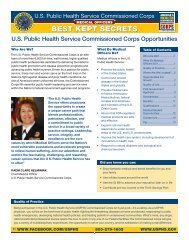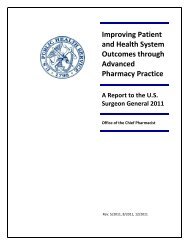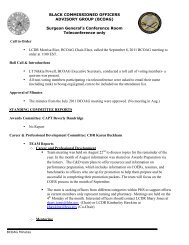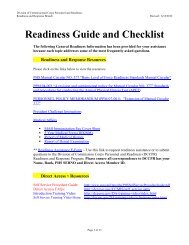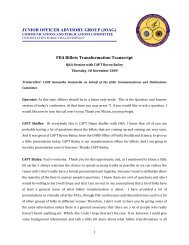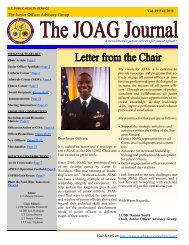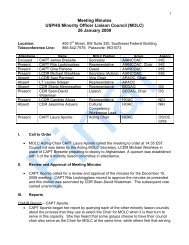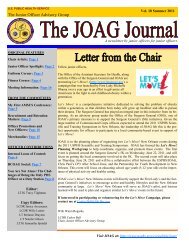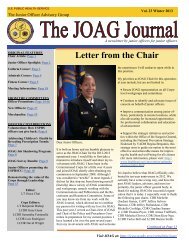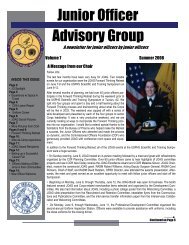Vol. 17 Winter - U.S. Public Health Service Commissioned Corps
Vol. 17 Winter - U.S. Public Health Service Commissioned Corps
Vol. 17 Winter - U.S. Public Health Service Commissioned Corps
You also want an ePaper? Increase the reach of your titles
YUMPU automatically turns print PDFs into web optimized ePapers that Google loves.
The JOAG JournalPage 6National Honor Flight Program: A Soldier’s StoryContributed by CDR Blakeley (Denkinger) Fitzpatrick*on behalf of the Inter-<strong>Service</strong>s Collaboration Committee, Community <strong>Service</strong> SubcommitteeI have always had a great appreciation for the men andwomen who have fought since the birth of our nation for thefreedom of all Americans. The events of the second WorldWar always seemed so distant and surreal when I read aboutthe war in history books or saw footage on TV, but then I meta piece of living history. Little did I know that when I volunteeredto provide assistance to veterans visiting the WWIImonument through Honor Flight that I would meet a newfriend for life.We were taking pictures, pushing veterans in wheelchairs, andlistening to recounts of war stories throughout the morningwhen a busload of veterans from Ohio pulled up. DonaldCurfman was one of the first veterans to step off the bus. Ioffered to take a picture of Mr. Curfman at the entrance of thememorial and then we began chatting about our current lives.As we walked and talked, he slowly began to tell me about hisexperiences during the war.After being orphaned as a child, Mr. Curfman joined theArmy at the age of <strong>17</strong>. He chose to join the 82 nd Airborne, theArmy‘s first airborne division, because it paid more whichallowed him to send money home to support his mother andsister. Shortly after arriving in England, he was told that hewould be going into battle the next day with the 325 th GliderInfantry Regiment. A glider is a small aircraft without anengine that is towed behind an airplane and released. None ofthe soldiers had either seen a glider before or received trainingon how to operate them. The evening before being sent intobattle, soldiers were told that after the glider was releasedfrom the airplane it would circle three times and then land.Staff sergeant Curfman sat in a small seat at the very front ofthe glider so that higher ranking soldiers could sit in the betterseats in the back. After the glider was released, Mr. Curfmannoticed little pin pricks of light coming through the ceiling.He then realized that those points of light were holes in thecanvas glider. The aircraft had taken on flak and instead ofcircling three times and coming to a smooth stop, the glidercrash landed next to a farm house killing several occupantsupon impact. After the glider crashed, the aircraft came underenemy fire coming from the direction of the farm house. Mr.Curfman jostled the first sergeant sitting in front of him urginghim to get out and flee, but then realized the first sergeanthad been shot and killed. Once he pried his legs free from themangled glider and retreated from the enemy fire, Mr.Curfman realized he was the sole survivor and he wasstranded in a foreign land with no sign of other living membersof the 82 nd Airborne.Pictured: SSG Donald CurfmanMr. Curfman eventually rejoined American Troops and waspart of the thousands of troops that fought for the capture ofCologne, Frankfurt, and Strasburg over the course of 1 ½years. He was sent to the Ardennes Forest in Belgium for a10 day rest and was told that he would be going home soonafter, but instead the Germans launched a surprise attack with250,000 troops and 600 tanks in December of 1944 whichkept him in the fight.During the war, many American troops only had the protectionof the light uniforms they were issued when they weresent to Europe in spring and summer. In temperatures thatwere below freezing, thousands of American troops fought forover a month in brutal conditions through what becameknown as the Battle of the Bulge. The Battle of the Bulge isthe largest battle ever fought by the Army. Over 19,000 menwere killed and over 60,000 were captured and/or wounded.Despite such devastating losses, this battle was a turning pointin the war, one that Mr. Curfman was a part of.When it was time for Mr. Curfman to leave the WWII memorial,we exchanged numbers and addresses and promised towrite. Not a week has gone by since then that I have not spokenor written to Mr. Curfman. I later learned that he hadnever spoken of his experiences during the war before. I feelhonored that he chose to share his stories with me.I want to encourage all junior officers to volunteer for thisworthy cause. WWII veterans are dying at a rate of more than1,000 per day. <strong>Vol</strong>unteering through Honor Flight is not onlya way to provide assistance to former service members, it is away to preserve the stories and history of our country before itis lost.*Since the event LCDR Fitzpatrick received Exceptional Proficiency Promotion to CDR
<strong>Vol</strong>. <strong>17</strong> <strong>Winter</strong> 2011Page 7Alumni Contact Initiative: Getting Our Alma Maters InvolvedContributed by LCDR Scott Steffen and LCDR Shani Smithon behalf of the Recruitment and Retention CommitteeThe United States <strong>Public</strong> <strong>Health</strong> <strong>Service</strong> (USPHS) has anexcellent history of acquiring outstanding personnel fromnumerous institutions to support our mission. It wasquickly realized that our officers are a great resource toaccess these outstanding institutions and to continue thisfine tradition of recruitment. In June 2008, LCDR RobinToblin, as a member of the JOAG Recruitment and RetentionCommittee, proposed the idea of officers establishingcontact with their alma maters for recruitment purposes inthe form of the Alumni Contact Initiative (ACI). LCDR‘sToblin and Liatte Krueger volunteered to lead this effort tofoster these relationships between officers and schools bycreating a series of documents— an Alumni Contact ProgramOverview, an Instruction Guide, a document listingsuggested contacts, a Contact Tracker, and Alumni Contacttemplate letters—which were presented and approvedby the JOAG leadership. These documents, which arepending final approval from the Division of <strong>Commissioned</strong><strong>Corps</strong> Recruitment (DCCR), will be packaged aspart of the DCCR‘s ―Recruitment Tool Box‖ and used tofulfill the Initiative‘s mission: ―To increase the visibilityof the USPHS and demonstrate the endless opportunitiesthat the <strong>Corps</strong> has to offer in an individualized and crediblemanner.‖ACI will be overseen by DCCR; however, due to the extensivebreadth of our categories the Professional AdvisoryCommittees (PACs) will have a critical role in thisinitiative. Each PAC will be responsible for crafting theirown specific program in which to deploy these pre-madecategory-specific template letters. Moreover, initiating,tracking, and evaluating the effectiveness of the categoryspecifictemplate letters will be the responsibility of eachPAC in conjunction with the DCCR‘s Associate RecruiterProgram and will be based on strong communication betweenthese two entities.The main goal of the ACI is to increase the visibility of theUSPHS through personalized communication. To accomplishthis, each officer will only need to add their personaltouch to the first paragraph of each template letter whilethe remaining letter can be left untouched. Officers candistribute the letters through automated e-mail to theiralma mater‘s student listserv, university career centers,or at university career fairs. After students respond tothe personalized letter, officers are encouraged to referpotential candidates to the following resources for moreinformation: the Recruitment Call Center (1-800-279-1605), the USPHS website http://www.usphs.gov/RecruitmentMaterials/, and the USPHS facebook page(http://www.facebook.com/USPHS). If a candidate intendsto apply for a commission, it is highly recommendedthat the candidate complete the online prescreenquestionnaire at: http://www.usphs.gov/applynow/.Overall the Alumni Contact Initiative will provide a cost-effective means to recruit potential officers withoutoverwhelming active duty officers. Once the RecruitmentTool Box has been finalized by DCCR and thePACs have developed their programs, all interested officersshould contact their PAC leadership to obtain theappropriate documentation and category-specific template.Together, we can increase the visibility of the<strong>Corps</strong> dramatically by sending out just a couple of lettersand help our fellow alumni by informing them ofthe excellent career opportunities in the USPHS.JOAG’s mission is to provide advice andconsultation to the Surgeon General, ChiefProfessional Officers, Professional AdvisoryCommittees, & other <strong>Commissioned</strong> <strong>Corps</strong>groups on issues relating to professional practiceand personnel activities affecting Junior Officersin the USPHS <strong>Commissioned</strong> <strong>Corps</strong>.Visit JOAG at: http://www.usphs.gov/corpslinks/joag/
The JOAG JournalPage 8I Call It RecruitingContributed by LT Bill LehaultWould you be where you are today without the educationor encouragement provided by a United State <strong>Public</strong><strong>Health</strong> <strong>Service</strong> (USPHS) officer? If you are like me, theanswer is probably no. Just over one year ago I became acommissioned officer in USPHS. I am elated with mydecision to join the <strong>Commissioned</strong> <strong>Corps</strong>, and I enjoyinforming others of the lifestyle it has provided me onboth a personal and professional level. Some call it bragging;I call it recruiting. Either way, I enjoy getting theword out about a branch of the service I am proud to be apart of.I personally knew little about the <strong>Corps</strong> prior to startingthe application process. The concern that others knew aslittle as I, combined with my aforementioned sense ofpride, formulated a desire to spread the word. When peopleask me what I do for a living, I do not reply ―I am apharmacist,‖ rather ―I am an officer in the <strong>Commissioned</strong><strong>Corps</strong>.‖ The inquiring party almost universally responds,―The what?‖ We then spend a few minutes discussingwhat the USPHS is. Brief conversations as simple as theone mentioned increase the populous‘ knowledge aboutwho we are and what we do. On several occasions theparty I am talking to even knows ―someone who wouldbe interested in that (USPHS).‖Shortly after joining the <strong>Corps</strong>, I became the Point ofContact for my alma mater, The University of Rhode IslandCollege of Pharmacy. I started my mission bysending out a mass email to the student body. Withindays, dozens of responses poured in, and from there,phone conversations. The students knowledge of USPHSwas minimal if not absent. The simple act of informingthem of the opportunities with USPHS was enough topique their interest. From the extensive benefits to thediverse professional options, the students were intrigued.LT Bill Lehault in the lobby of the URI's ForgartyHall prior to his recruitment lectureI visited the University this past October to discuss recruitmentefforts with faculty, talk to students, and give alecture followed by a Q&A to approximately 150 pharmacystudents. Upon my arrival, I was welcomed bystaff and students alike. During the presentation, studentswere both engaged and inquisitive. Those in their earlieryears were interested in the CoStep programs, while otherscloser to graduation asked about vacancies and theapplication process. I continue to correspond with severalindividuals I met that day. It has been very rewardingto facilitate the students‘ decisions on career paths. Adifficult choice we all have faced in our lives.I am writing of my efforts not to brag about what I amdoing but to recruit. It is not only an endeavor that youwill find satisfying but it is imperative to increasing thepublic‘s awareness of our existence and improving theoverall quality of the <strong>Corps</strong>. If you have pride in whatyou do, let it show. If people are intrigued about yourbranch of service, talk to them. If students or young professionalsneed assistance, help them. And always remember,if someone never took the time with you, youwould not be where you are today.
<strong>Vol</strong>. <strong>17</strong> <strong>Winter</strong> 2011Page 9Bridging <strong>Health</strong> Disparities in the Detention SettingContributed by LCDR Linda EgwimAddressing health care disparities has become a nationalissue in the United States. The same is truewithin the detention health care system. As health careproviders, we serve many chronically ill adults in thedetention and prison setting. These patient populationsare not accepting of the medical treatment we offer tothem for various reasons that might be related to theircultural or religious beliefs, norms, and values; lack oftrust in the healthcare system; language barrier; andpersonal conviction. This is why we must join the fightfor health promotion and disease prevention by understandingthis unique patient population.We have to be sensitive to our patients‘ diverse culturalbackgrounds including their food, beliefs, customs,language, and religion. It is imperative that weidentify and acknowledge our patients‘ culture and tradition.In order for our patients to accept the healthcare(Western medicine), we must develop trust with them.Through honesty, compassion and body language indicatingunderstanding, we can achieve this.There are several things that healthcare professionalscan do during an encounter with the detained patientsto engender trust. Individuals may feel guilt and shamefor their incarceration. Show empathy by telling themthat their feelings are real and fair.Let the detainee know that you are partnering withthem to manage their health care needs not dictatingtheir care. Empower them to take ownership of theirhealth needs. Stress that you are supportive of theirhealth care decisions, but providing them with factualinformation to improve their health. Bear in mind thatindividuals who have been in the correctional systemfor years have been compelled to follow orders frompeople in authority. They may decline the recommendedhealthcare because this is one of the only areaswhere they have the right to exercise their freedom.As health care providers, we must explain to the patientsthe disease process, treatment options and potentialcomplications. Use medical diagrams from a reliableand reputable company. Share your findings includingphysical examination, and diagnostic result(vital signs and lab results). Make the patient feel likehe/she is your top concern. Finally, ensure that thehealth education is culturally sensitive and within thepatient‘s level of comprehension. In doing so, you helpPHS promote its mission, in turn, provide personal fulfillmentfor you as a provider.To our General Membership:JOAG is able to thrive due to thework that is done by ourcommittees and workgroups.Thank you to the entire generalmembership for making this anexceptional organization!Visit JOAG at: http://www.usphs.gov/corpslinks/joag/
<strong>Vol</strong>. The <strong>17</strong> JOAG <strong>Winter</strong> Journal 2011 Page 10Yellow Dust: Confronting the Danger Lurking in aCommunity’s BasementsContributed by LT Racquel Stephenson and LT Elena VaouliFor most of us, our basements are a safe haven for familygatherings, for doing laundry, and for storage. But forsome residents in one Garfield, NJ neighborhood, theirbasements are a health hazard. Groundwater near the ECElectroplating site in Garfield, NJ is contaminated withhexavalent chromium, a carcinogen. The contaminationhas affected a neighborhood of 709 homes and severalcommercial and mixed use properties. The basements ofsome of these properties flood during heavy rains withchromium-contaminated water. When the water recedes,the chromium dries out and leaves a yellow dust that canpose a health risk to persons living in or using the basements.Residents can be exposed to harmful levels ofhexavalent chromium by accidentally swallowing andbreathing in this contaminated dust. The Agency forToxic Substances and Disease Registry (ATSDR) issueda <strong>Public</strong> <strong>Health</strong> Advisory for the site, which providedresources for expedited clean-up and extensive communityoutreach.LT Stephenson and LT Vaouli were the only junior officerson the ATSDR scientific team that worked to issuethe Advisory. This was a critical move for the Agency,and the first advisory to be issued in 10 years. Advisoriesare issued at sites where there is an imminent healththreat, which is precisely what the residents of Garfieldwere facing. Hexavalent chromium dust concentrationswere very high in some basements, with calculated exposuredoses significantly higher than ATSDR‘s healthguideline comparison values. At these concentrations,residents could experience acute health effects and are atan increased risk for developing cancer. As a result, thesite was characterized as posing an urgent public healthhazard.Pictured: Yellow dust containing hexavalent chromiumLT Stephenson and LT Vaouli conducted technical reviewof the Advisory document, factsheets, and pressreleases. They helped to plan a public meeting, briefingsof federal and local elected officials, press briefings, andhealth education outreach in the community. As a resultof the team‘s efforts, the Environmental ProtectionAgency (EPA) will propose the site be placed on the NationalPriorities List (NPL). The NPL is the list of themost seriously contaminated sites among the known releasesor threatened releases of hazardous substancesthroughout the United States and its territories. It is intendedprimarily to guide the EPA in determining whichsites warrant further investigation and is part of theSuperfund clean-up process. In Garfield, site remediationwill incorporate short- to mid-term strategies such as waterproofingbasements, as well as long-term strategies toremove hexavalent chromium from the groundwater.Without the issuance of a public health advisory, the residentsaffected by the contaminated groundwater may nothave received the most thorough clean-up remedies available.LT Stephenson and LT Vaouli‘s hard work contributedto the success of a rare public health action byATSDR, and most importantly, achieved the mission ofprotecting, promoting and advancing the health andsafety of a New Jersey community.For more information on the ATSDR advisory and letterhealth consultation for the site visit: http://www.atsdr.cdc.gov/sites/ec_electroplating/
<strong>Vol</strong>. <strong>17</strong> <strong>Winter</strong> 2011Page 11Giving Back This HolidayContributed by LTJG Benjie De Veraon behalf of COA Greater LA ChapterEveryone is aware of how bad and damaging economicrecessions are to some families. As junior officers of the<strong>Commissioned</strong> <strong>Corps</strong>, we‘re all in a great position to contributewhat we can to make a difference to those who arein need, especially during the holiday season.The Holiday Season reminds us that we have the choiceto help those in need. As junior officers, let us all carrythis spirit of giving forward into the new year and continueto make a difference to those who benefit from oursupport and service.In Los Angeles County, over a million men, women andchildren are at risk of going to bed hungry every night. Inearly December, the local chapter COA-Greater LA led byLCDR Chau Vu and LT Nick Lahey, collaborated with thestudents from California State University Long Beach<strong>Health</strong> Science Department (CSULB) to volunteer at theLA Regional Foodbank. In this noble mission, PHS officersand CSULB <strong>Health</strong> Science students joined the fightagainst hunger by repackaging food to distribute to thehungry of Los Angeles.Another event organized this winter by COA-Greater LAwith the CSULB <strong>Health</strong> Science Department was Adopt-A-Family. Anyone who has participated in Adopt-A-Familyknows how truly rewarding this experience could be. Thefeedback from PHS officers, students and families has alwaysbeen very positive, so we have decided to continueto make this event an annual tradition in Greater LA.COA Greater LA Chapter at LA Regional Foodbank.LT Jessica Lee, LTJG De Vera, and CSULB <strong>Health</strong> Sciencestudents with Adopt-A-Family.Visit JOAG at: http://www.usphs.gov/corpslinks/joag/
The JOAG JournalPage 12Flying “Space Available”Contributed by LCDR Matthew Weinburkeon behalf of Inter-<strong>Service</strong>s Collaboration Committee, MWR SubcommitteeTraveling Space Available (Space-A) is like traveling ona ―magical mystery tour‖, stated LCDR Sue Partridge(colleague assigned to CDC). ―You can have a lot of fun,but you have to be willing to be patient. It‘s not an exactscience. Flights get cancelled, or flights are postponed oryou may get bumped off the schedule. It‘s not for thosewho need their vacation to be organized and wellplanned. But, in August, 2010, the benefit has saved usapproximately $1,000 per person! For us, it‘s worth theinconvenience‖, said LCDR Partridge, who has traveledwith her husband and child to Europe several timesthrough the Space-A program.Space-A is a travel benefit that allows authorized passengersto occupy unused seats on DoD-owned or-controlled aircrafts. It is a privilege (not an entitlement)available to all Uniformed <strong>Service</strong>s members and theirdependents. Space-A passengers are eligible for any remainingseats only after all duty cargo and passengershave been accommodated. As USPHS <strong>Commissioned</strong><strong>Corps</strong> officers, we are allowed the privilege to use theSpace-A travel benefit on a non-mission interference basisonly. Family members (dependants) may travel withinthe CONUS (Continental United States) or OCONUS(outside the CONUS) on these flights when accompaniedby their sponsor.Categories of TravelIn Space-A terms, your category of travel is your priority.Priority is based on six categories of eligibility related tostatus and situation. The numerical order indicates theprecedence of movement. For more information on categoriesof travel visit, go to: http://www.amc.af.mil/amctravel/spaceatravelcategories.aspLocations and Flight SchedulesThe majority of Space-A flights are offered by the AirForce‘s Air Mobility Command (AMC) or the Navy, andSpace-A seats are normally free. AMC locations can befound on the following website:http://www.amc.af.mil/shared/media/document/AFD-100108-019.swfFor more information on flight schedules, go to:http://www.amc.af.mil/amctravel/amctravelcontacts.aspDocuments and Other RequirementsIn most situations, all active duty USPHS officers will beprioritized as Category 3 and will be required to present aCAC card and leave form. For more information, goto:http://www.amc.af.mil/amctravel/travelguidance.aspRegistrationOnce travelers are assigned a category upon registering,they compete for seats within categories based on thedate and time of registration. When registering for Space-A , sign up BOTH for departure and for return flights (2separate registrations) at the same time.For more information on registration, go to: http://www.amc.af.mil/amctravel/spaceavailablesign-up/index.aspShow Time and other Requirements―Show time‖ is the term used for when Space-A seats arenormally identified, shortly before the departure of theaircraft. Confirmation of the seat(s) may be given as earlyas 2-3 hours before, or as late as 30 minutes prior to, departure.It is recommended that you check with the passengerservice center for the space available ―show time‖prior to arriving at the terminal. Be ready for immediateprocessing and boarding.BaggageEach passenger may check two pieces of checked baggage,
<strong>Vol</strong>. <strong>17</strong> <strong>Winter</strong> 2011Page 13JOAG Congratulates all Junior Officerson their recent/upcoming promotions!(Promotion Cycle: Jan.—Apr. 2011)Contributed by the JOAG Welcoming CommitteeTo Commander (O-5)DentalSharon Anne Raghubar 02/01/2011DieticianJoseph Thomas Frost 04/01/2011EngineerMelissa Bradley Burns 04/01/2011James Douglas Ebert 03/01/2011John David Mazorra 01/01/2011Kelly E. Mortensen 01/01/2011Luke Leon Schulte 03/01/2011Environmental <strong>Health</strong>Lisa Joe Delaney 01/01/2011Bradley Steve King 04/01/2011Stephen Robert Piontkowski 01/01/2011Richard E. Skaggs Jr. 01/01/2011<strong>Health</strong> <strong>Service</strong>sLaurie A. Brown 04/01/2011Shari W. Campbell 02/01/2011Jean-Pierre Pierre Debarros 01/01/2011Suzie Amelia. Garza 01/01/2011Ryan D. Hill 01/01/2011Verna Marie Kuka 01/01/2011Peter Robert Lenahan 01/01/2011Robin Marie Lewis 02/01/2011Claudine Michele Samanic 01/01/2011James C. Yee 01/01/2011NurseLeigh Ann Bernardino 04/01/2011Yolanda R. Burke 04/01/2011Wanda D. Chestnut 04/01/2011Rebecca Anne Fox 01/01/2011Cheryl Lynn Garza 04/01/2011Kristin R. Hamlin 04/01/2011To Commander (O-5)NurseSyketha JuenesseMilburn-Mcroy 01/01/2011Steve Laurier Morin 01/01/2011Alexis Mosquera 01/01/2011Dianne Christine Paraoan 01/01/2011Shedrick L Toussaint 01/01/2011Margarita Rocio Velarde 03/01/2011James Lindsay. Webb Jr. 04/01/2011Marc E. Winokur 01/01/2011Ardis R. Zah 01/01/2011PharmacistKavita Dada 04/01/2011Eun Joong Oh 01/01/2011Luke Sunghyun Park 01/01/2011ScientistVincen Gene Barnes 01/01/2011David Joel Beckstead 01/01/2011Lauren Bailey Zapata 04/01/2011TherapistPhilip Matthew Chorosevic 01/01/2011To Lieutenant Commander (O-4)DieticianTracy Nichole Gregg 01/01/2011EngineerHelena Attakai 01/01/2011Jon Harald Bergeron 01/01/2011Darron Clark 01/01/2011Mark Hench 01/01/2011Julia Clare Kane 01/01/2011Continued on Page 14Visit JOAG at: http://www.usphs.gov/corpslinks/joag/
The JOAG JournalPage 14JOAG Congratulates all Junior Officerson their recent/upcoming promotions!(Promotion Cycle: Jan.—Apr. 2011)Contributed by the JOAG Welcoming CommitteeLieutenant Commander (O-4)EngineerShad Michael Schoppert 01/01/2011Environmental <strong>Health</strong>Timothy Matthew Albright 01/01/2011Latasha Anasa Allen 04/01/2011Jessica E. Hensley 04/01/2011Katherine Noonan. Hubbard 01/01/2011Jasen Michael Kunz 01/01/2011Stephanie R. Coffey 01/01/2011Elisa Joy Dubreuil 01/01/2011Jessica E. Hensley 04/01/2011Katherine Noonan. Hubbard 01/01/2011Jasen Michael Kunz 01/01/2011Eva Daneke Mclanahan 01/01/2011<strong>Health</strong> <strong>Service</strong>sKarla Hembrick Bowens 01/01/2011Charles John Brucklier 01/01/2011James B. Carr Jr. 01/01/2011Clifford Eugene Coleman 01/01/2011Kojo Danso 04/01/2011Irina Pashina Gaberman 04/01/2011Whitney H. Gadsby 04/01/2011Michael Allen Henson 04/01/2011Yonette Rhea Hercules 04/01/2011Darrell William Jones 01/01/2011Carl Jevon Lawson 01/01/2011Adam Waring Lofton 04/01/2011Donelle D. Mckenna 01/01/2011Donald Walter Mott 01/01/2011Evelyn Renee Pleasanton 04/01/2011Steven E. Porter Jr. 04/01/2011Willie R. Vasquez JR 04/01/2011NurseTonya Nichol Cornwell 01/01/2011Larry John Demers 04/01/2011Florina Esplain 01/01/2011Jessica Sue Figlenski 01/01/2011Lieutenant Commander (O-4)NurseScott Allen Griffith 04/01/2011Nahleen Carol Heard 01/01/2011Shannon M. Little Wolf 04/01/2011Katherine Altoria Maye 01/01/2011Jonathan David Merrell 01/01/2011Tiffany Griffith Moore 01/01/2011Monique Pressoir 01/01/2011Orlando Rodriguez-Flores 01/01/2011Marilyn Quinlan Sale 01/01/2011Addie Vanessa Scott 01/01/2011Andrea Denise Smith 04/01/2011Robert Samuel Swain 04/01/2011Phoebe AntoinetteUnderwood-Davis 04/01/2011Humberto Villalobos 01/01/2011Sherry Renea Wall 04/01/2011Timothy Neil Watkins 01/01/2011Melinda Denise Welka 01/01/2011PharmacistGabriel Renard Mclemore 01/01/2011Carolyn Terrado Pumares 01/01/2011Ashley R. Schaber 01/01/2011Lisa Lee Hua Tung 01/01/2011ScientistAlexander Balbir 01/01/2011Sharyn Elaine Parks 01/01/2011Bobby Babak Rasulnia 01/01/2011Erin Kristine Sauber-Schatz 01/01/2011Benjamin Johnathan Silk 01/01/2011Sara J Vagi 01/01/2011TherapistJennifer Christina Bebo 01/01/2011VeterinarianJaspreet Kaur Gill 04/01/2011Megin Christina Nichols 04/01/2011
<strong>Vol</strong>. <strong>17</strong> <strong>Winter</strong> 2011Page 15JOAG Welcomes 27 Newly <strong>Commissioned</strong> Officers!(Sep. - Dec. 2010)Contributed by the JOAG Welcoming CommitteeBOPLT Tracy ChristLT Troy MatthewsENS Brian AlexanderENS Elizabeth HoltENS Michelle KrayerENS Joy McelyeaENS Jennifer PondENS Julie TaylorENS Michael VansickleCDCLT Sharanya KrisnhnanDOD TMALCDR Carla Chase-StandiferLCDR Kari HarrisLCDR Tracy SkiptonLT Robert BurnsLT Indira HarrisLT David LewisLT Cole WeeksFDAENS Stephen FriedmanHRSALT Benoit MirindiIHSLCDR Charles LovellLT Anthony GlydwellLT Dyanne MedinaLT Amanda HillLT Julia MajkrzakLTJG Rickesha ClarkENS Tyrrell LangNIHENS Tonya JenkinsENS Anthony ValloricCall for Nominations for Voting MembersNomination Deadline:Friday, April 1, 2011The Junior Officer Advisory Group (JOAG) requests nominationsfor 11 open positions for voting membership for 2011-2013.Application MaterialsThe application can be found on the JOAG website at:http://www.usphs.gov/corpslinks/joag/index_files/About_JOAG_Membership.htmIf you know motivated and dedicated junior officers, pleaseencourage them to self-nominate for the following open slots:At-Large Member (4 openings)Environmental <strong>Health</strong> LiaisonDentist LiaisonDietician LiaisonPharmacist LiaisonPhysician LiaisonScientist LiaisonVeterinarian LiaisonFor questions or to submit nominations for voting membership,contact LCDR Irene Z. Chan, Chair, Membership Committee,at irene.chan2@fda.hhs.gov.2011 Call for Award NominationsNomination Deadline:Friday, March 25, 2011The Junior Officer Advisory Group (JOAG) is requesting nominationsfor three awards to be presented at the annual USPHS Scientificand Training Symposium to be held in New Orleans, LA,from June 19-23, 2011.If you know any outstanding officers deserving the recognition ofthese awards, please see the JOAG Awards website at http://www.usphs.gov/corpslinks/joag/index_files/Awards.htm for details.You can also contact one of the JOAG Awards CommitteeCo-Chairs, LCDR Merel Kozlosky at kozloskym@cc.nih.gov orLT Benjamin Chadwick at benjamin.chadwick@ihs.gov, or one ofthe JOAG Award Leads listed below for nomination details.Nominations are due to the appropriate JOAG Award Lead listedbelow no later than COB on Friday, March 25, 2011.Send nominations or questions for the JOAG Excellence Awardto: LT Adora NduEmail: adora.ndu@fda.hhs.gov; Phone: 301-796-5114Send nominations or questions for the Junior Officer of the YearAward to: LCDR Barbara CohnEmail: barbara.cohn@ihs.gov; Phone: 406-638-3313Send nominations or questions for the VADM Richard H. CarmonaInspiration Award to: LCDR Tiffany SandersEmail: tisanders@bop.gov; Phone: 203-312-5374
The JOAG JournalPage 16Letter from the Chair (continued)Continued from Page 1In an effort to ensure junior officers had a voice in this process,JOAG nominated six junior officers for these workgroups.As previously mentioned, four were selected to representJOAG on four of the ten workgroups. Although six workgroupsdo not have JOAG nominated officers, each of theworkgroups do include junior officers as part of their membership.These ten workgroups are: 1) Division of Civilian MedicalReserve <strong>Corps</strong>; 2) Division of Science and Communications;3) Division of <strong>Commissioned</strong> <strong>Corps</strong> Personnel andReadiness; 4) Division of Systems Integration; 5) RecruitmentBranch; 6) Assignments and Career Management Branch; 7)Assignment Team; 8) Training Team; 9) Personnel ManagementSupport Team; and 10) Readiness, Deployment andReady Reserve Branch.Additionally, the <strong>Corps</strong> continues to move forward with thefollowing initiatives:Billet Transformation: categories are at various stagesof completion at this time.Ready Reserve Implementation: current efforts are directedat determining the size, skills, employment, etc. forReady Reserve officers.GI Transferability Bill: ongoing discussions continue atthe Department level to get the details of the Post-9/11Veterans Educational Assistance Improvements Act of2010 completed. This Bill will allow PHS <strong>Commissioned</strong><strong>Corps</strong> officers to transfer educational benefits providedby the Post 9/11 GI Bill to dependent family members. Inorder for the Post 9/11 GI Bill transferability to be effectivefor the <strong>Commissioned</strong> <strong>Corps</strong>, transferability must bein the interest of national security and be approved by theHHS Secretary. Specific details on what this means arestill being discussed.The lifting of the pause and the pending reorganization of the<strong>Corps</strong> brought about many questions from junior officers.This is why I felt it essential to have <strong>Commissioned</strong> <strong>Corps</strong>leadership come address JOAG during the February 11, 2011JOAG General Meeting. We were honored to have RADMBoris Lushniak, Deputy Surgeon General, and RADM ChristopherHalliday, OSG Chief of Staff, address JOAG members.The Admirals started off by acknowledging the important roleJOAG plays within the <strong>Corps</strong>. They also stated that the SurgeonGeneral appreciates junior officers‘ enthusiasm duringthese difficult times, our insight on what is important for thefuture of the <strong>Corps</strong>, and our leadership, as demonstrated bybeing part of an organization like JOAG.The meeting allowed an opportunity for frank, candid discussionsbetween <strong>Corps</strong> leadership and junior officers present atthe meeting. I believe this session was tremendously helpful inreducing any anxiety surrounding many of the unknownscoming from the passage of the PPACA, and will undoubtedlylead to improved future communication between <strong>Corps</strong> leadershipand JOAG.As we move from focusing on activities related to the overall<strong>Corps</strong>, I would now like to recognize some of the great workbeing done by the JOAG committees:The Policy and Procedures Committee and the ProfessionalDevelopment Committee will soon distribute the MembershipSurvey to junior officers via the JOAG listserv. This surveywill help JOAG identify gaps in our organization as perceivedby our general membership.The Professional Development Committee is currently workingon finalizing the JOAG Career Pyramid. The career pyramidwas designed with the intent to assist junior officers betterunderstand the requirements expected of them during thecourse of their careers. In addition, the pyramid serves as aPHS career development tool for mentors to guide their protégés.The JOAG Strategic Plan is currently being reviewed andupdated to help JOAG align its priority and mission into thenext 5 years.The Recruitment and Retention Committee’s COSTEP ConnectionProgram have developed the COSTEP Non-Select RecruitmentProgram in collaboration with the <strong>Commissioned</strong><strong>Corps</strong> Recruitment Branch (formerly known as Div. of <strong>Commissioned</strong><strong>Corps</strong> Recruitment).Although in very early stages, JOAG is currently looking intohow we can assist the Surgeon General with the First Lady'sLet’s Move Initiative.These are just some of the exciting projects that we have beeninvolved in for the last several months. As you can see, thereis plenty to do, and we are always looking for enthusiastic participantsto assist within our ten JOAG Committees.I would also like to remind and encourage all junior officersthat the Membership Committee is now accepting nominationsfor JOAG Voting Membership. For more informationon how to apply, please visit the About JOAG – Membershipwebpage of the JOAG website. Additionally, the JOAGAwards Committee is also accepting nominations for thethree JOAG Awards that will be presented during this year‘sCOF; The JOAG Excellence Award, The Junior Officer of theYear Award, and the VADM Richard H. Carmona InspirationalAward. Application and instructions can be found underthe Awards section of the JOAG website.Lastly, I want to end by thanking all of our active JOAG participants.It is through you that JOAG continues to thrive andhave a direct impact in the future of our <strong>Corps</strong>. As always, ifyou want to get involved and be part of this historical time inour <strong>Corps</strong>, I encourage you to become active by joining one ofour many JOAG committees.With Warm Regards,LCDR Carlos BellChair, Junior Officer Advisory Group
<strong>Vol</strong>. <strong>17</strong> <strong>Winter</strong> 2011Page <strong>17</strong>MerchandiseJOAG MedallionThe JOAG Medallion serves as a constant reminderthat we are officers in the <strong>Commissioned</strong><strong>Corps</strong>. It also serves to remind us ofcertain characteristics an officer must have:generosity, elevation of mind, goodness, nobility,camaraderie, and the continuity of theseideals through time.$10 per coin plus $1 shipping and handlingPHS Core Values CoinThe PHS Core Values Coin serves to remind allofficers of the four <strong>Commissioned</strong> <strong>Corps</strong>Values of Leadership, <strong>Service</strong>, Integrity, andExcellence.$10 per coin plus $1 shipping and handlingUSPHS Coin RackThis solid pacific coast maple coin rackmeasures 7‖x9‖ and has five rows thatcan hold military and USPHS coins. It hasthe USPHS seal and mission laser engravedon the front.Now available for pre-order for $26/rackplus $5 shipping and handlingInterested in pre-ordering? Visit the Merchandise section of the JOAG website to viewthe order form and instructions:http://www.usphs.gov/corpslinks/JOAG/index_files/Merchandise.htmFor questions related to purchasing items please or contact LCDR Robin Toblin, JOAG FinancialLiaison at Robin.L.Toblin@us.army.mil.
The JOAG JournalPage 18JOIN OUR MEETINGSJOAG General Meeting and JourneymanSeries2010-2011April 8, 2011:General Membership Meeting, 1300-1500 EDTMay 13, 2011:Journeyman Speaker Series, 1300– 1400 EDTJune 20-23, 2011 (COF Symposium):General Membership Meeting, 1300-1500 EDTJuly 8, 2011:Journeyman Speaker Series, 1300– 1400 EDTAugust 12, 2011:General Membership Meeting, 1300-1500 EDTSeptember 9, 2011:Journeyman Speaker Series, 1300– 1400 EDTJoin us for JOAG’s monthly meetings via teleconferenceor in person* on thesecond Friday of each month.By Conference Call: (218) 936-4700Passcode: 791-9605#In Person*:Parklawn BuildingFDA‘s White Oak CampusSurgeon General‘s Conf.Rm 18-57Bldg 51, Conf.Rm. 12195600 Fishers Lane Room 18-5710903 New Hampshire AvenueRockville, MD 20857Silver Spring, MD 20993* Only for the JOAG General Membership MeetingsMiss a JOAG Meeting? Don’tdespair! JOAG meetings arerecorded. Audio recordings are available “on demand” by e-mailingLT Hiren Patel at Hiren.Patel@fda.hhs.govEditor’s Note: A very special thanks toLT Natalie Gibson for her hard work asa copy editor for the Fall issue of theJOAG Journal.This newsletter has been provided by the JOAGCommunications & <strong>Public</strong>ations Committee.For more information on how to contribute tofuture editions, please contact LCDR Janice Arceneauxand LCDR Christina Coriz, CommitteeChairs, or LTJG Tracy Tilghman , JOAG EditingSubcommittee lead.Any opinions or thoughts presented in the JOAG Journal are solely those of the author and do not represent the U.S. <strong>Public</strong><strong>Health</strong> <strong>Service</strong>, United States Department of <strong>Health</strong> and Human <strong>Service</strong>s (HHS), or any other government agency.



